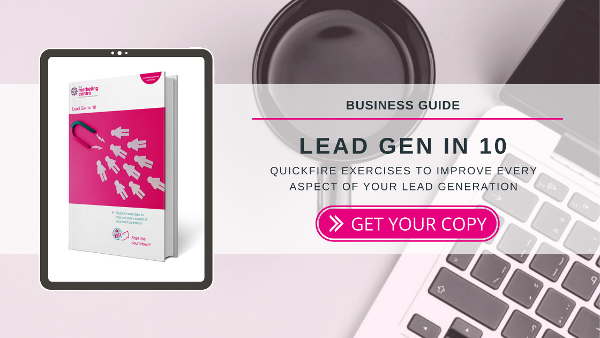Just “doing marketing” is no longer enough.
Now, with millions of companies attempting to cut through the noise and vie for their audience’s attention, you need to do more. Your marketing needs to be sophisticated enough to cut through this noise and reach - and convince - your target market.
The Marketing Centre’s Robert Stead - a highly-skilled B2B marketing director with a wealth of European and international experience - is a vocal advocate of the integrated, campaign-based approach to marketing. Here’s why.
What is a campaign?
Marketing is a cumulative activity rather than using a single tactic in isolation. A campaign, specifically, is an organised course of action to promote and sell a specific product or service.
“Organised” is an important word here. “It’s got to have many different dimensions”, says Robert. “The more different dimensions there are, the more likely it is to work”.
Many businesses talk about campaigns in the sense of email campaigns, webinar campaigns, social media campaigns and the like. However, these are not campaigns in the truest sense: they are simply cases of mistaking the methodology - or a single activity for a campaign.
Is your marketing activity up to scratch? Find out with our free Marketing 360 Assessment.
Instead, a campaign is a group of activities working together to achieve a core purpose or goal. Robert cites the example of one client of his whose marketing activity was previously very disjointed.
“They’d make a webinar, then invite people to it. They’d create an email and invite people to read the email. They’d do some social posts and hope people would read them”, he says. “But it wasn’t the same audience or the same message. There was some fantastic content, but it wasn’t related to any particular target audience, and there was no process bringing it all together.”
Robert approached this activity from another angle. He set out to understand who the company was trying to sell to, where these people are, the messaging that should be used. “We then fine-tuned the content to meet these needs and assembled it into a coherent structure”, he explains. “Email on Monday, social coverage on Tuesday, webinar Wednesday, case study Thursday and so on”.
This approach transformed the results. Instead of the previous disjointed approach, prospects were now receiving a consistent set of messages that were relevant to their needs.
Why is a campaign approach important?
Salesforce estimates that “it takes 6-8 marketing touches to generate a viable sales lead”. Offering a single touchpoint with your brand - whether it’s a simple email campaign or an in-depth face-to-face conversation - simply isn’t enough.
The campaign approach ensures that you are offering multiple marketing touchpoints - both inbound and outbound. Using several different methods to reach your target audience, using the same message and with a clear structure, is what works.
The three essentials of every campaign
There are three vital elements to every successful marketing campaign.
1. Contacts
Establish who you want to talk to. Define your target audience. Be as specific as you can.
2. Content
Research the challenges that these people have and align your content accordingly. What sort of messaging will resonate with them and help you - and them - to achieve your goals?
3. Process
Determine how you will deliver this marketing content to these contacts. The process you decide on will depend on the first two elements and will also need to be measurable. Without measuring the results, you will have no idea whether the campaign has been successful and whether certain elements need tweaking.
Speaking of success…
9 rules for a successful campaign
1. Get the right contacts
You are unlikely to succeed without targeting the right people with the right roles in the right businesses.
To find the sectors in which you are most likely to succeed, first look at where you have previously done business - “it’s the best indicator you can possibly have”, says Robert.
He recalls spending a couple of hours in a workshop with a sales team to establish exactly who they spoke to, why, and how they were targeted when they won business. “A marketing director wants to have good conversations with the right person. A sales director often wants to have as many conversations as possible with as many people as possible because surely someone will want to buy”, he says.
Robert stresses that one contact isn’t enough. The end-user and the decision-maker may be two separate people - do you fully understand the business’ decision-making unit? Have you undertaken a win/loss analysis and established how decisions are actually made? “Once you understand all of this at one organisation, you can go and find the same job roles at another organisation”, says Robert. “You’ll find that you’ve then got quite a good audience”.
It is important too to look at your existing database. This was the case with the business Robert described earlier. “They’d done a mountain of ad hoc activities”, he says. “It turned out they already had a substantial database of the right people, but just didn’t realise it”.
2. Have engaging content that adds value
The human brain is exposed to a vast amount of information every day. The more information that we’re exposed to, the less easy it is to take any of it in.
Even the best crafted of messages can be reduced to mere noise - and noise irritates.
To succeed, you need an approach that stands out. A good campaign will include engaging content that resonates with its audience and adds value. Focus on what your audience wants to hear about more than what you want to tell them.
3. One touch is never enough
A few decades ago, a consumer’s path to purchase was far more simple. Now, though, far more research is often needed before making a purchase decision.
For businesses, this means that your target buyers will need to encounter your brand several different times - and in different ways - before they choose whether or not to part with their money.
With 6-8 marketing touches needed to generate a viable sales lead, it’s essential to make sure that you give these people enough information and appear in front of them enough - in the right way, with the right message - to get them sales-ready.
4. Use multiple channels
On the subject of touchpoints, don’t just rely on a single channel to reach your target market. Emails, traditional advertising, blog posts, word of mouth recommendations, webinars, online reviews, website visits - these touchpoints can make many different forms - explore all of those that are relevant.
It is also important to ensure a good mix of outbound channels (things you send to your prospects) and inbound marketing (things the prospect finds independently).
5. Keep the messaging stable
Confused or bloated messaging could rapidly reduce your pool of leads. If you want your prospects to get a true idea of who you really are, you need to keep your messaging stable.
Repetition and consistency are key to successful lead generation. Hammering your message home - in the right way - will pave the way to awareness of, respect for and trust in your brand and your offering.
6. It’s for the long term
The proportion of your target market that is proactively looking to purchase at any given time will be tiny. Common wisdom states that if you target the right contacts with the right materials, 3% will be ready to buy now - and 33% will be ready to buy at some point in the future.
“Unfortunately”, says Robert, “you can’t tell who’s active in the market and who’s not at the start of these activities. It’s just about being there when the right moment comes - the inbound logic of being there when you’re needed”.
If someone you contact isn’t ready to buy now, don’t qualify them out, but nurture them until they are.
7. Balance inbound and outbound communication
Focusing purely on outbound communication may make your prospects feel too much like they are being sold to. Focusing purely on inbound communication will fail to give them the prompt they need when they’re at the right point in their purchase journey.
Looking for marketing support? Find out how we can help.
A good balance between both inbound and outbound communication is vital. Outbound channels may include a combination of some or all of: email, telephone calls, direct mail, face to face visits, advertising and PPC. Inbound marketing could include elements such as a web pillar page, social posts, videos, white papers, blogs and organic SEO.
8. It’s a process
“Activity begets results”, says Robert. “But that activity has to be structured in the right way”.
He cites two examples of businesses that are beginning to make this work. The first is a business that has implemented an integrated marketing strategy and is seeing a greater volume of inbound calls. “The structure and the success are very easy to see”, says Robert. “But they don’t yet have a good enough internal process to be able to tie together all the activity to the exact sales results”.
The other example is a business that had a vast amount of content but wasn’t using that content in the right way. “Having taken this content into a campaign process, they’re starting to see really good results”, he says. “If you lose your ad hoc thinking and add a bit of structure and process, you’re inevitably going to do better”.
Implementing a process is one thing; tracking it, learning from it and improving is another. Choosing the right CRM can help you to make this happen.
9. Know what you want to achieve from the outset
Every campaign you run should have measurable objectives attached to it. How will you know if it has been a success without clear and tangible goals?
The goals you set should be SMART: specific, measurable, achievable, realistic and timely. For most, these campaign goals are likely to revolve around the number of leads and sales that they achieve.
But how many leads is realistic?
Once you’ve defined your financial targets, you’ll be able to work backwards to understand how many leads you will need to hit these targets.
This exercise will make it happen. All you need is your sales data for the last 12 months, your financial targets for the 12 months ahead, and a spreadsheet or calculator. By the end of the exercise, you’ll know exactly how many needs you need to generate with your campaign.
It all starts with leads
A campaign-based approach to marketing, when done right, will cut through the noise and get the attention it deserves from your audience.
Every good campaign generates quality leads. The exercise we shared above will help you to establish how many leads you need. However, you’ll also need to:
Define what a “good lead” looks like
Choose the right lead generation approach
Map out the roles and responsibilities you need to push leads through the funnel Increase the number of leads that become paying customers
Our Lead Gen in 10 workbook gives you five quick, practical exercises to improve every aspect of your lead generation. Download the workbook here - or get in touch for more campaign-based marketing insight.




